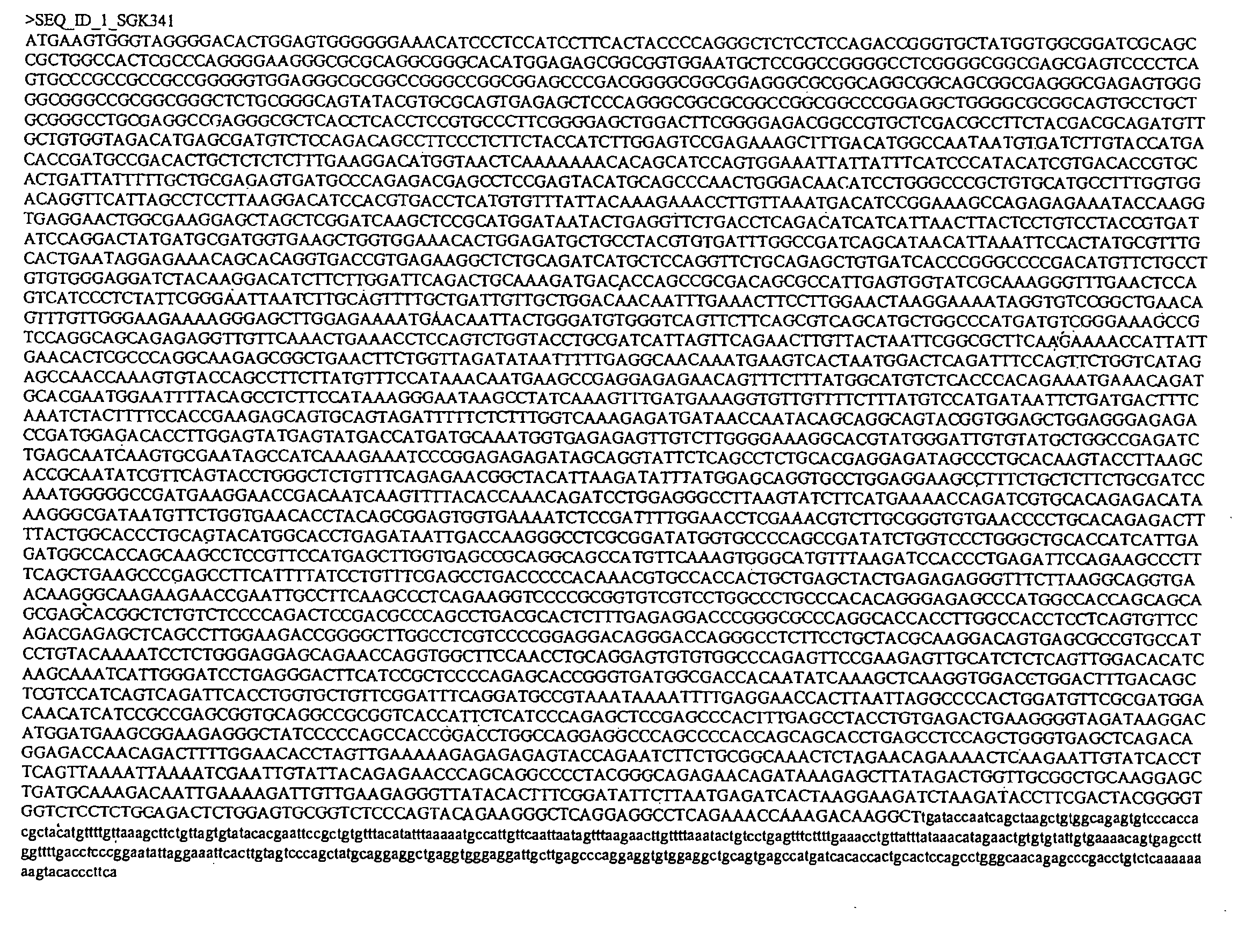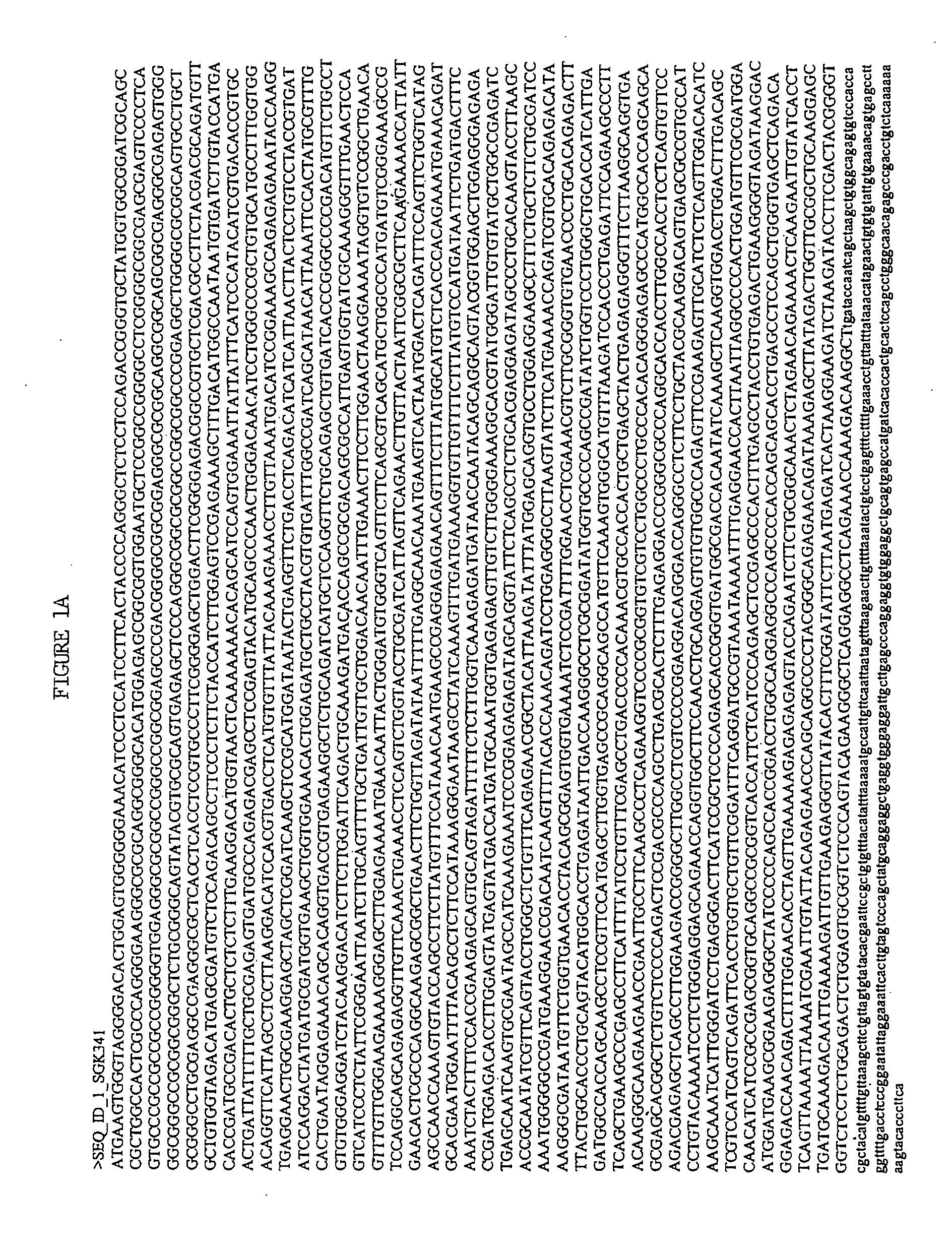Novel human protein kinases and protein kinase-like enzymes
a technology of protein kinase and protein kinase, which is applied in the direction of peptides, peptides/protein ingredients, transferases, etc., can solve the problems that mammalian kinases cannot complement the nim phenotype, and achieve the effects of increasing or decreasing the probability of a complex, and increasing or decreasing the probability
- Summary
- Abstract
- Description
- Claims
- Application Information
AI Technical Summary
Benefits of technology
Problems solved by technology
Method used
Image
Examples
example 1
Identification and Characterization of Genomic Fragments Encoding Protein Kinases
Materials and Methods
[0370] Novel kinases were identified from the Celera human genomic sequence databases, and from the public Human Genome Sequencing project (http: / / www.ncbi.nlm.nih.gov / ) using a hidden Markov model (HMMR) built with 70 mammalian and yeast kinase catalytic domain sequences. These sequences were chosen from a comprehensive collection of kinases such that no two sequences had more than 50% sequence identity. The genomic database entries were translated in six open reading frames and searched against the model using a Timelogic Decypher box with a Field programmable array (FPGA) accelerated version of HMMR2.1. The DNA sequences encoding the predicted protein sequences aligning to the HMMR profile were extracted from the original genomic database. The nucleic acid sequences were then clustered using the Pangea Clustering tool to eliminated repetitive entries. The putative protein kina...
example 2a
Expression Analysis of Polypeptides of the Invention
[0384] The gene expression patterns for selected genes were studied using a PCR screen of 96 human tissues. This technique does not yield quantitative expression levels between tissues, but does identify which tissues express the gene at a level detectable by PCR and those which do not.
example 2b
Predicted Proteins
[0385] SGK341, SEQ ID NOS: 1 and 3, encodes a protein that is 1360 amino acids long. It is classified as a protein kinase in the STE11 family. The kinase domain in this protein matches the hidden Markov profile for a full length kinase domain of 261 amino acids from profile position 3 to profile position 261. The position of the kinase catalytic region within the encoded protein is from amino acid 701 to amino acid 955. The results of a Smith Waterman search of the public database of amino acid sequences (NRAA) with this protein sequence yielded the following results: Pscore=1.2e-315; number of identical amino acids=783; percent identity=58%; percent similarity=74%; the accession number of the most similar entry in NRAA is NP—005914; the name or description, and species, of the most similar protein in NRAA is M3K5 (MEKK 5, ASK1) [Homo sapiens].
[0386] SGK35 1, SEQ ID NOS: 2 and 4, encodes a protein that is 198 amino acids long. It is classified as (superfamily / gro...
PUM
| Property | Measurement | Unit |
|---|---|---|
| Temperature | aaaaa | aaaaa |
| Molar density | aaaaa | aaaaa |
| Molar density | aaaaa | aaaaa |
Abstract
Description
Claims
Application Information
 Login to View More
Login to View More - R&D
- Intellectual Property
- Life Sciences
- Materials
- Tech Scout
- Unparalleled Data Quality
- Higher Quality Content
- 60% Fewer Hallucinations
Browse by: Latest US Patents, China's latest patents, Technical Efficacy Thesaurus, Application Domain, Technology Topic, Popular Technical Reports.
© 2025 PatSnap. All rights reserved.Legal|Privacy policy|Modern Slavery Act Transparency Statement|Sitemap|About US| Contact US: help@patsnap.com



